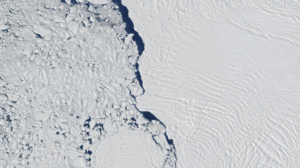Harnessing physics-informed machine learning for ice sheet dynamics
The Greenland and Antarctic Ice Sheets are the largest reservoirs of freshwater on Earth. If they were to melt entirely, global sea levels would rise by an average of 65 metres. Over recent decades, it has become clear that the ice sheets are losing mass, and that this ice loss has accelerated. Despite warmer atmospheric and ocean conditions, this change is not principally due to the direct melting of ice, but changes to the speed at which ice flows towards the sea – a process referred to as ice dynamics. Unfortunately, our understanding of ice dynamics is incomplete, and we have difficulty representing key processes accurately and efficiently in numerical models. This forms the largest source of uncertainty in projected future sea level rise.
Models, such as those who’s output contributes to the IPCC reports, treat ice dynamics as a viscous flow problem – and solve the associated set of equations numerically. Recent developments in the field of machine learning – particularly deep learning (the subset of ML that deals with neural networks) – have resulted in new ways to tackle these problems and augment existing methods. These have shown particular promise in enhancing the ways in which we use data to infer the processes that govern dynamics, as well as speeding up simulations of ice flow. Taken together with the wealth of satellite data that has illuminated the Earth’s polar regions in recent decades, the opportunity for data-driven solutions to longstanding problems in ice dynamics has never been greater.

This project will investigate the use of machine learning in the intersection of numerical modelling and Earth observation to improve our understanding of Antarctic ice dynamics. You will use physics-informed neural networks to enhance the ways in which we gain insights into ice sheet processes and characteristics from large-scale ice velocity, thickness and surface-elevation change datasets. By processing your own satellite data, largely from the European Space Agency’s Sentinel-1 (SAR) and Sentinel-2 (optical) satellites, you will generate datasets of fracture around Antarctica, and develop new ways to use this data in conjunction with existing and novel ice sheet modelling frameworks to understand how small-scale brittle fracture interacts with the large-scale viscous deformation. The project can be taken in a number of other directions including pioneering the use of new machine-learning emulators to generate ensembles of ice sheet evolution or focussing on the parametrisation of small scale processes such as the sliding of ice streams over the bedrock below.
Through supervision by Dr Surawy-Stepney (University of Leeds) you will learn to use machine learning approaches to analyse satellite data of the Earth’s ice sheets and model glacier flow. Co-supervision by Professor Hogg (University of Leeds) will provide expertise in satellite-based remote sensing of the polar regions, and give you access to a decade of ice speed measurements, which form the foundation of our understanding of ice dynamics. Professor Livermore (University of Leeds) and Dr Lai (Stanford University) will provide expertise in a wide range of data-driven methods including physics-informed machine learning, along with a wealth of experience in geophysical fluid dynamics, inverse methods and glaciology.
During your PhD you will be part of the world-leading Institute for Climate and Atmospheric Science, based in the School of Earth and Environment at the University of Leeds. We encourage enthusiastic, ambitious and mathematically-minded students to apply, who hold a very good undergraduate or Masters degree in physics, mathematics, computer science, engineering or a related discipline. An understanding of programming is valued but not required, as is any previous experience geographical/climate/environmental science. We welcome applications from a wide range of backgrounds, including those with non-traditional qualifications or from industry – please contact us to have a chat about your suitability for the programme.
